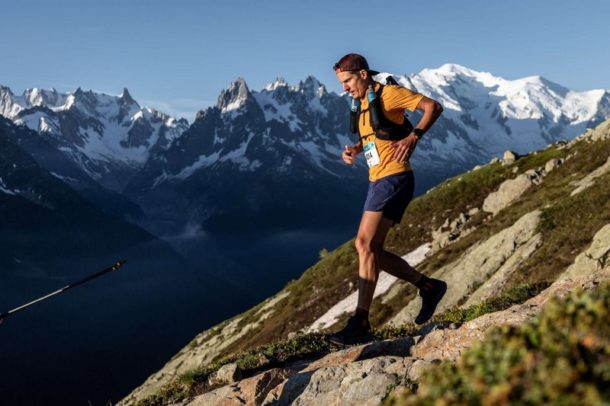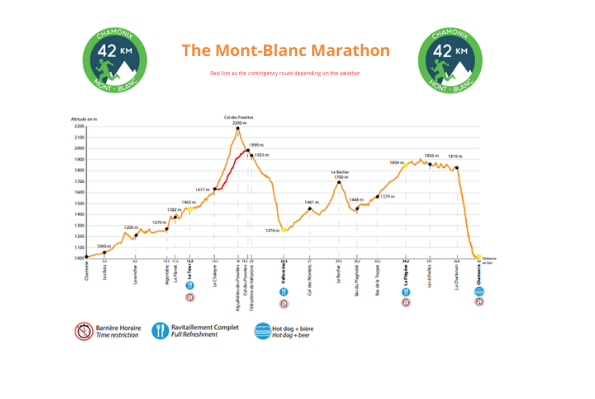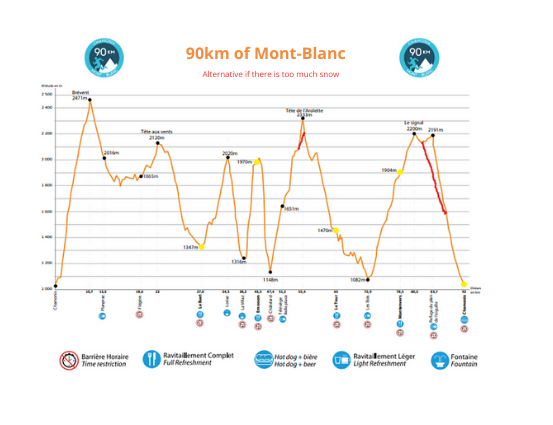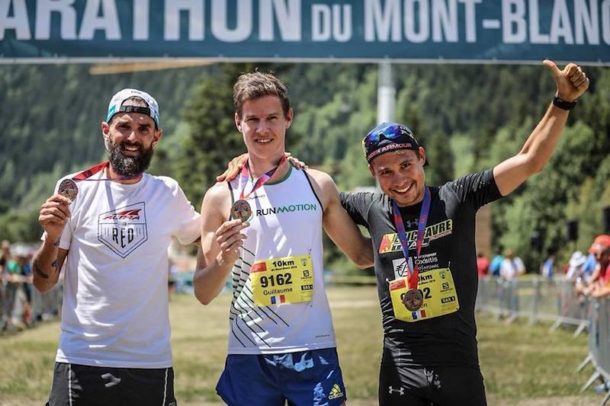
Are you gearing up for one of the exhilarating races at the Mont-Blanc Marathon? Whether you’ve signed up for the 10 km of Mont-Blanc, the Mont-Blanc Cross (23 km), the classic Mont-Blanc Marathon (42 km), the challenging 90 km of Mont-Blanc, the VK or the Duo étoilé, prepare to be enthralled by the breathtaking backdrop of Chamonix, set against the awe-inspiring Mont-Blanc.
It’s crucial to note that most of these races, with the exception of the 10 km, feature a considerable elevation gain, demanding exceptional endurance and strength. Thus, a well-structured training plan tailored for the Mont-Blanc Marathon’s unique challenges is not just beneficial; it’s a necessity for a successful and enjoyable race experience.
Contents
The Basics of a trail training plan
Your trail training plan should include a variety of sessions: run-hiking, hill intervals, downhill training, strength training,etc.
Weather conditions in June, the month of the Mont-Blanc Marathon, can be quite unpredictable. You may encounter intense heat, but there’s also a chance of stormy weather. It’s advisable to train in warmer conditions in May and June to acclimate your body to the potential heat. However, balance is key – avoid training in the heat too frequently to prevent excessive fatigue. This approach will ensure that you are well-prepared for any weather scenario on race day.
Run-Hiking trainings for the Mont-Blanc Marathon
Run-hiking is normally the foundation of a training plan for trail and ultra-trail running. If you are participating in the 10km or 23km of Mont-Blanc, you can do run-hiking outgoings of about 2 hours, which is sufficient. If you are running the Mont-Blanc Marathon, you can increase to 4 hours of run-hiking, and even up to 5 to 6 hours for the 90km of Mont-Blanc.
You can optionally complement this with a long bike ride on the same weekend as your run-hiking training.
Hill training sessions
There are two main types of hill training sessions.
Long Hills
Long hills sessions work on endurance, with workouts like 4×6 minutes or 3×10 minutes uphill. If possible, choose hills long enough so you don’t have to go back down to the bottom after each repetition, to avoid a recovery that’s too long.
Short hills
Short hills sessions focus on strength and positioning. They are particularly suitable when you don’t have much time or if you live in a city without direct access to the mountains. An example would be 12×25 seconds with a recovery jog downhill, or up to 8×1’30.
At the end of the recovery, which is done by jogging downhill, you can either start again directly or add a 30-second wall sit before starting again to add an extra challenge (not in the first sessions, but rather when you have done several in the season).
Downhill training for the Mont-Blanc Marathon
The Mont-Blanc Marathon and the 90 km of Mont-Blanc races culminate with challenging downhill sections towards Chamonix, making strong legs an indispensable asset. For instance, the 90 km race features a demanding descent of 1200 meters over 8 km, beginning from Le Signal. Similarly, the 42 km marathon includes a steep 800-meter descent across 5 km, presenting a comparable challenge in terms of gradient.

To excel in these downhill segments, integrating specific downhill training into your regimen is crucial. This training could include, for example, 10 repetitions of 1-minute downhill runs at a brisk pace. Alternatively, consider completing descents with 500 to 1000 meters of negative elevation in a single stretch without breaks. Such focused training not only strengthens your legs but also enhances your ability to maintain control and speed during prolonged downhill sections, a skill that is vital for success in these races.
Muscle strengthening training for trail running
For trail and ultra-trail efforts, it is important to undertake appropriate strength and conditioning workouts, especially for alpine trails with a high elevation gain.
In the 90 km of Mont-Blanc, the first climb to Brévent is nearly 1500m of positive elevation gain over 10 km. If you haven’t done muscle strengthening or trained for elevation gain, your thighs and calves will really feel the strain! The stretch between km28 and km55 is also tough, with Loriaz, Emosson, and the Tête de l’Arolette, amounting to 2500m of elevation gain (D+) and 1500m of descent (D-) over 27 km!

The course of the 23 km of Mont-Blanc, formerly known as the Cross du Mont-Blanc, features a generally uphill route, without major descents. However, if there is too much snow, a contingency route ends in Chamonix instead of Planpraz, and in this case, it involves nearly 900 meters of negative elevation gain in less than 5 km!

You can do circuit training or sequences of jumping exercises and strength training like those found in the RunMotion Coach app (Strength and Conditioning workouts in Premium mode only). You can also incorporate cycling or home training exercises into your routine to enhance strength and endurance. For example, try exerting maximum effort over short durations or use a higher gear for sustained uphill riding.
If you are in the city, stairs can be a good way to work on muscle strengthening.
Thoroughly test your equipment before the Mont-Blanc Marathon
Given that the weather in Chamonix is often hot and sunny during the day, it’s crucial to thoroughly test your equipment during training. This is particularly important for your technical t-shirts, shorts, and underwear to prevent irritation. Additionally, ensure you rigorously test your trail running backpack, especially if you haven’t used it in many races at the beginning of the season.
Due to the possibility of sudden thunderstorms in late June in the Mont-Blanc Massif, carrying a waterproof windbreaker and the rest of the mandatory gear, including a survival blanket, is essential.
If you plan to use poles in the race, regularly incorporate them into your training. Practicing with them on both ascents and descents will improve your efficiency and comfort during the race.
We wish you effective training and highly recommend downloading the personalized training app RunMotion Coach, the Official Coach of the Mont-Blanc Marathon. Running in the Chamonix valley is a magical experience for trail runners!

Photo credits: Mont-Blanc Marathon –David Gonthier